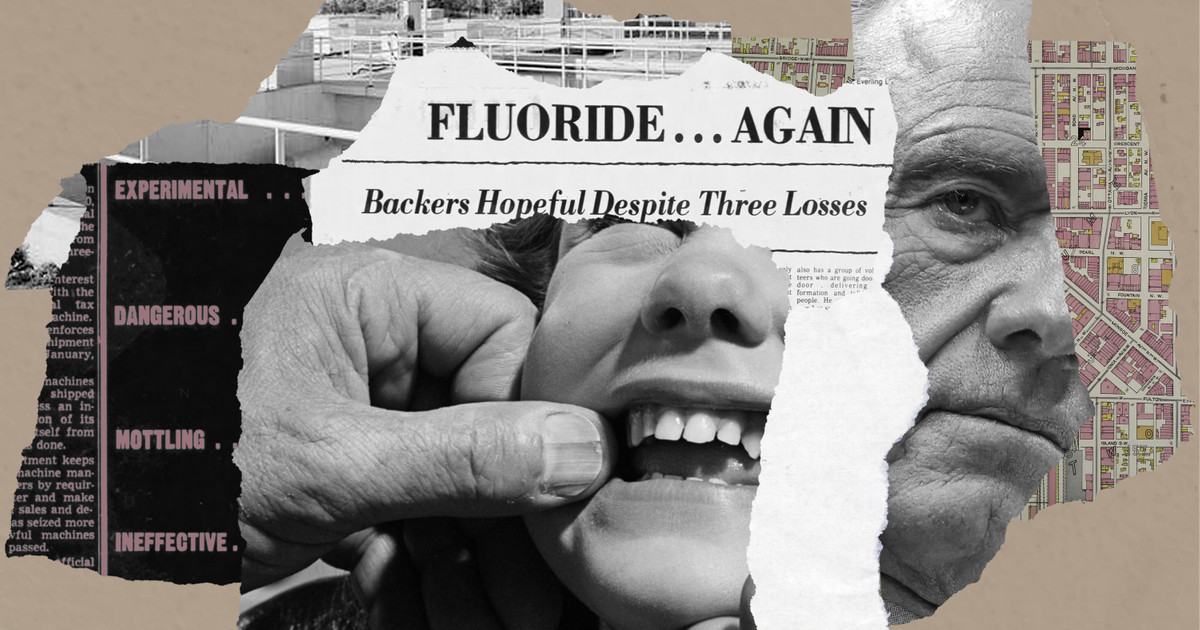
Just 15 months after receiving an award from the Centers for Disease Control and Prevention for excellence in community water fluoridation, the city of Grayling, Michigan, changed course.
With little notice or fanfare, council members voted unanimously in May to end Grayling’s decadeslong treatment program. The city shut down the equipment used to deliver the drinking water additive less than two weeks later.
Although it already paid for them, the town returned six unopened barrels of the fluoride treatment to the supplier.
Personal choice was the issue, said City Manager Erich Podjaske. “Why are we forcing something on residents and business owners, some of which don’t want fluoride in their water?” he said. He saw arguments for and against treatment in his research, he said, and figured that those who want fluoride can still get it at the dentist or in their toothpaste.
Drinking water fluoridation is widely heralded as a public health triumph, but it’s had critics since it was pioneered 80 years ago in Grand Rapids, about 150 miles southwest of Grayling. While once largely on the fringes, fluoridation skeptics now hold sway in federal, state and local government, and their arguments have seeped into the mainstream.
Even in the state where the treatment began, communities are backpedaling. And because customer notice requirements are patchy, people may not even know about it when their fluoridation stops.
Robert F. Kennedy Jr., secretary of the Department of Health and Human Services, has called fluoride “industrial waste” and supports an end to community water fluoridation. The head of the Food and Drug Administration said on a newscast that the CDC’s online description of water fluoridation as one of the greatest public health achievements is “misinformation.”
The CDC, which is in the midst of a leadership exodus and staff revolt, and the Environmental Protection Agency are reviewing their respective approaches to fluoride in drinking water. At the same time, President Donald Trump’s administration dismantled the CDC’s Division of Oral Health, which, among other initiatives, provided research and technical assistance on fluoridation. That’s the office that helped present awards for well-run programs like the one in Grayling.
Since Kennedy was elevated to the nation’s top health post, Utah and Florida became the first states to ban communities from adding fluoride to public drinking water. The Utah ban included measures to make prescription fluoride supplements more accessible — but now, the FDA is moving to remove certain types of those supplements for children from the market.
Altogether, legislation was introduced this year in at least 21 states to prohibit or roll back provisions related to adding fluoride to public water systems, according to Abby Francl, policy analyst at the National Conference of State Legislatures. In addition, citing Kennedy’s “Make America Healthy Again” initiative, Oklahoma’s governor issued an executive order instructing state agencies to cease promotion of fluoridation in the public water supply while it reviews the practice.
Some local communities across the country opted to stop treatment this year, including at least four in Alabama, the state with the second-lowest number of dentists per resident. Others are debating it. On Michigan’s east side, the medical director of St. Clair County’s health department urged the agency to take steps to “prohibit the addition of fluoride” to public water systems. Two Upper Peninsula cities with a shared water system had special council meetings this summer on fluoridation. In Hillsdale, the acting mayor has said that ending fluoridation is a top priority.
“I want to reform the water system now that we have RFK in Health and Human Services,” Joshua Paladino told a local paper in November. Paladino added in an email to ProPublica that he sees public water fluoridation as an imprecise tool because it gives a standard dose across the population.
According to Michigan’s environmental agency, some communities had temporarily stopped fluoridation and were “hesitant to restart because of uncertainty.” That prompted it to issue a five-page statement with the state health department in March, stressing that the levels recommended for water suppliers — 0.7 milligrams per liter of water — have no adverse health effects and that fluoridation benefits everyone.
“Local anti-fluoride movements can be vocal and persistent, but do not necessarily represent the viewpoints of the greater community,” the statement said.
Communities that end fluoridation will see more decaying teeth, according to Margherita Fontana, a professor at the University of Michigan School of Dentistry. Young children, older adults, people with disabilities and people who are poor are especially at risk, she said, but everyone will be vulnerable. Excessive tooth decay in children can require treatment in hospitals, under anesthesia. In rare but extreme cases, it can lead to death.
“It’s unfortunate, because we know how to prevent the disease,” Fontana said. “So it just seems like we’re going backwards in time rather than forward.”
A handful of states require customer notification when fluoridation ends. New York mandates such notice, yet fluoridation in Buffalo lapsed for years before it was widely known. Outside Detroit, the city of Wyandotte suspended treatment about a decade ago, despite saying on its website until early this summer that it used fluoride. The claim was removed only after a local reporter raised the issue.
Michigan doesn’t have a statewide protocol for notifying residents when fluoridation stops. The environmental agency’s spokesperson said in an email that while it strongly recommends that communities inform customers, it doesn’t have the authority to compel them.
Grayling’s water operator, Josh Carlson, said a district engineer at the agency told him he just needed to tell the state if the town decided to stop fluoridating the water.
“It was almost like she was caught off guard that we actually did it,” Carlson said.
From Fringe to Mainstream
Water fluoridation began in 1945 in Grand Rapids, Michigan’s second-largest city, as part of a planned trial intended to last 15 years. Muskegon, on the Lake Michigan shore, served as the control, meaning its water was not treated with a fluoride additive. An Illinois city with naturally occurring fluoride in its water was another point of comparison.
Six years in, Muskegon officials withdrew from the trial after determining that the health benefits were so significant, they couldn’t deny treatment any longer to Muskegon’s children. Similar studies elsewhere continued for years, showing positive outcomes.
“It was very usual to have dentures at a very young age” at the time, Fontana said. Fluoride treatment “was such a fantastic discovery, something so easy that nature already provided. It was already there. It was the greatest discovery, really, for oral health.”
Grand Rapids celebrates its role in public health history with plaques and a totemic sculpture. But the treatment has been criticized since the early days as, variously, a Communist plot, forced mass medication and an industrial byproduct that causes more harm than good. (Fluoride additives are commonly derived from the processing of phosphate fertilizer.)
Even as fluoridation became widespread, opposition persisted. Today’s critics note that fluoride is now available in toothpaste, as well as in ingestible drops and tablets like the ones for children that the FDA is working to remove from the marketplace. Dental care is also more accessible than it was in the 1940s. The need that fluoridated water was meant to address, critics say, isn’t as urgent.
While progress has made fluoridation’s effects less dramatic, they’re still significant. It was initially credited with a 65% reduction in tooth decay; now, it’s about 25%. No other fluoride source compares to the cost-effectiveness of drinking water, proponents say, especially for those least able to access dental care, either because of cost or because they live in areas with a shortage of dental providers.
Community water fluoridation is supported by the American Academy of Pediatrics, the American Dental Association and the American Medical Association. The CDC, at least for the moment, still recommends it.
Advocates say that its benefits are so pervasive, they’ve become invisible to many.
“Known benefits that are not visible, they take it for granted, whereas unknown risks are what they are always worried about,” said Jayanth Kumar, lead researcher on a systematic review of community water fluoridation and IQ. “Florida didn’t ban alcohol. Florida didn’t ban cigarettes. But they banned fluoride.”
Critics say the National Toxicology Program’s “state of the science” report from last year shows an association between fluoridated drinking water and a lowered IQ in children. But that assessment — which is both contested and much-cited — involves fluoride levels that are more than twice what the federal government recommends for drinking water, and it’s based on limited studies conducted outside the U.S., with different water conditions.
Even the report’s abstract says that “more studies are needed to fully understand the potential for lower fluoride exposure to affect children’s IQ.”
In a lawsuit brought against the EPA by groups opposed to water fluoridation, a district judge relied in part on the NTP analysis in ruling that fluoridation presents such an “unreasonable risk” that the agency must take action. Even as it appeals the decision, the EPA said its review of new science on fluoride in drinking water “is being done in coordination with Secretary Kennedy and HHS.”
The court ruling, the NTP report and the wavering stance of federal agencies have empowered a backlash to fluoridation in state and local governments.
Stuart Cooper, executive director of the Fluoride Action Network, said he’s seen momentum shift over the last two decades as his group sought to eliminate fluoride treatment, not least as a plaintiff in the EPA lawsuit. Kennedy has given a jolt to the movement, he said. Now, “we have allies at every level.”
“Legislators and city councilors are calling us instead of me having to do vice versa,” he said.
Tooth Decay and Regrets
In Grayling, questions about fluoridation were brewing for at least a year before the town changed course. Podjaske, the city manager, said he discussed it off and on with Carlson, the city’s water operator. When it came time to reorder the fluoride additive, Podjaske wondered: Is this really necessary?
Carlson asked the state’s environmental agency about the protocol for discontinuing treatment and was told to keep the state posted. In April, Podjaske suggested adding the fluoridation question to the City Council’s agenda. At the May meeting, the council voted 4-0 to end treatment.
“I figured the best option was don’t push it on people,’’ council member Jack Pettyjohn said about his vote. “Don’t force them to have it in their water.”
There wasn’t any outreach to the public or health experts ahead of the vote. Meeting minutes say that Podjaske and Carlson discussed the removal of the fluoride additive after the water operator received “additional education and training.”
But both men say that isn’t right. Fluoridation was already on the agenda when Carlson attended a training that wasn’t about the treatment, but where he had an informal conversation with an instructor that made him worry about fluoride’s safety.
The vote would’ve occurred even without Kennedy’s activism, Podjaske and Pettyjohn said. Carlson, though, noted how Grayling’s pivot played out in context of “some of the new narratives coming out of Washington.”
“There’s a lot of mixed feelings about RFK Jr., but he seems to be anti-fluoride,” Carlson said. “I don’t know if that’s driving people’s complaints about fluoride.” With the proliferation of social media, he said, “I could see that being a factor, in the fact there’s more people with an opinion now.”
At the same time, he said, locals are more tuned in to water issues following the Flint water crisis and the contamination of waterways with PFAS chemicals linked to a nearby military base. PFAS are a group of “forever chemicals” that can carry a cancer risk.
Carlson said that in the occasional feedback he’s gotten on fluoridation over the last couple of decades, “the negatives were more than the positives in recent years.”
Following input from the state environmental agency, Grayling posted a notice about the change online in August, 10 weeks after treatment stopped. Some people didn’t see it. Mary Bobenmoyer, owner and general manager of Our Town Coffee & Treats, didn’t know until a reporter asked her about it in late August. “They did it?” she said.
Bobenmoyer spent seven years as a dental assistant. She encourages children especially to get fluoride treatment at the dentist. But, she said, “I personally don’t think it should be filtered in our water. We should have free and clear water.”
Over in Grand Rapids, there’s sporadic pushback on fluoridation, said water system manager Wayne Jernberg. But he hasn’t noticed any recent escalation. And he doesn’t see why there would be.
“We rely on the science of us,” Jernberg said. “We’ve been adding it for 80 years, OK? And we don’t see any issues in our community.”
Meanwhile, reports on dental health have caused some communities that dropped fluoridation to reconsider.
In Canada, just across the river from Detroit, the City Council of Windsor, Ontario, voted to stop fluoridation in 2013 after lengthy public debate. Less than six years later, the county health agency reported troubling outcomes from oral health screenings at area schools. It found that the percentage of children with decay or requiring urgent care increased 51% in five years, while the percentage of children that didn’t require any care decreased by 43%. The Windsor council soon decided to reintroduce water fluoridation, citing it as “a key prevention strategy.”
In the province of Alberta, Calgary’s council voted in 2011 to stop fluoridation in part because of community skepticism and because expensive repairs to the equipment were needed, according to Councillor Gian-Carlo Carrà. But in time, researchers found that local children developed significantly more cavities than their peers in Edmonton, where water is fluoridated.
“We saved ourselves some money,” said Carrà. “Fast-forward 10 years, and the results are clear that dental outcomes for Calgarians are worse after 10 years of not having fluoride in the water.”
When fluoridation was put on the ballot in 2021, 62% of voters supported its reintroduction. It took more than 28 million Canadian dollars and several years to start treatment again.
But, Carrà said, those costs — and the money to run the system — seem worthwhile. “I’m just much more interested in doing as much good as I possibly can,” Carrà said.
In Grayling, speaking more than two months after voting to end the treatment, Pettyjohn said he has an open mind about the future of fluoridation. “I would totally look at readdressing it, especially if the people of Grayling really wanted us to,” he said.
For now, though, he said he’s heard nothing negative from residents.



